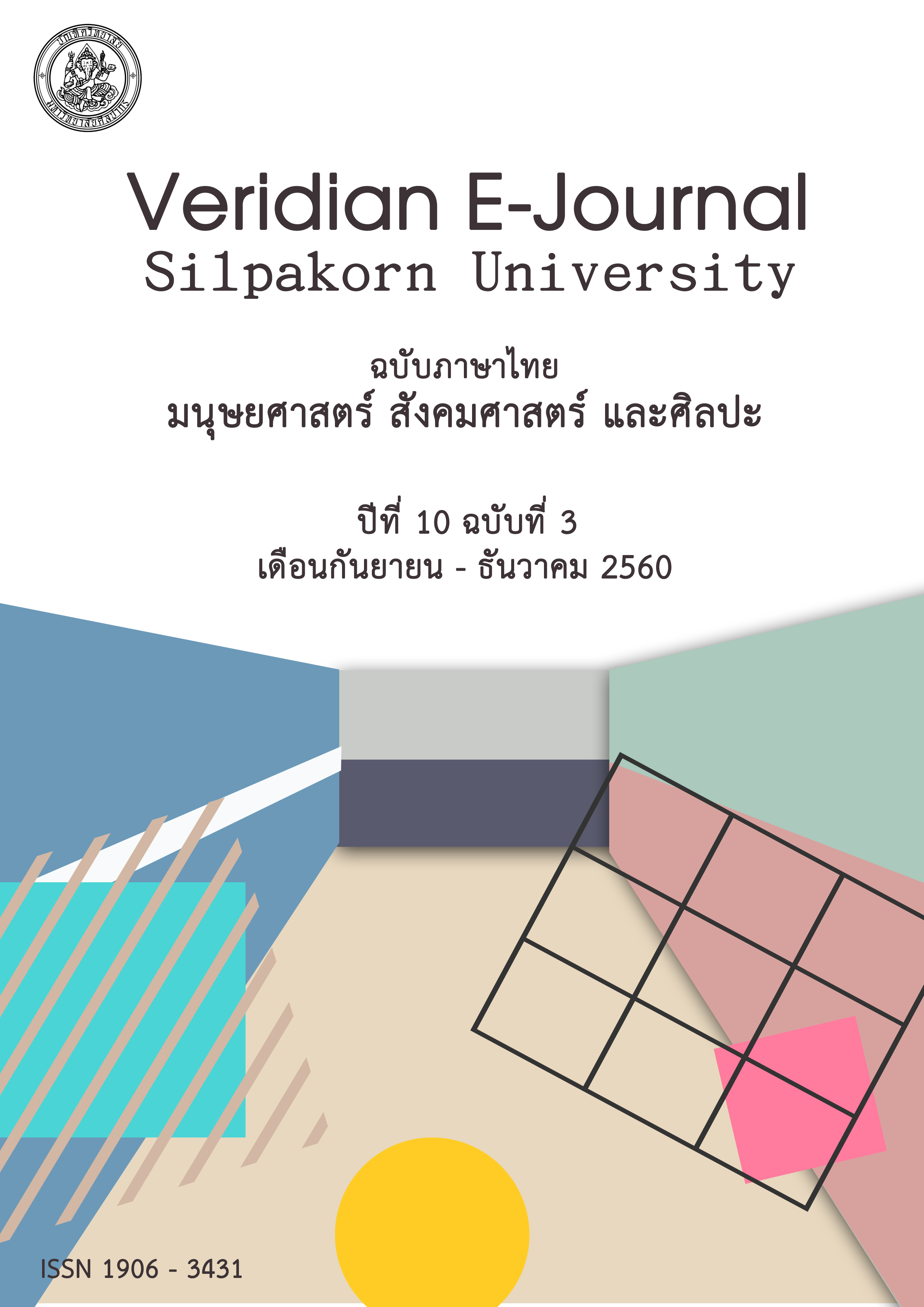การพัฒนาแนวการจัดการเรียนรู้วิชาภาษาไทยโดยใช้วรรณกรรมท้องถิ่นเป็นฐานร่วมกับการเรียนรู้แบบเชิงรุกเพื่อส่งเสริมความสามารถในศตวรรษที่ 21 ของผู้เรียน
Main Article Content
บทคัดย่อ
การพัฒนาแนวการจัดการเรียนรู้วิชาภาษาไทยโดยใช้วรรณกรรมท้องถิ่นเป็นฐานร่วมกับการเรียนรู้แบบเชิงรุกเพื่อส่งเสริมความสามารถในศตวรรษที่ 21 ของผู้เรียน มีวัตถุประสงค์เพื่อ 1. วิเคราะห์วรรณกรรมท้องถิ่นเรื่องสุภาษิตฉบับปัญญาในด้านต่าง ๆ ดังนี้ 1.1 ปริวรรตวรรณกรรมท้องถิ่นจากภาษาไทยโบราณเป็นภาษาไทยปัจจุบัน 1.2 วิเคราะห์วรรณกรรมท้องถิ่นตามแนวทางวรรณคดีศึกษา 1.3 วิเคราะห์วรรณกรรมท้องถิ่นตามแนวทางทางคติชนวิทยา จิตวิทยา และสังคมวิทยา 2. พัฒนาแนวการจัดการเรียนรู้วิชาภาษาไทยโดยใช้วรรณกรรมท้องถิ่นเป็นฐานร่วมกับการเรียนรู้แบบเชิงรุก เพื่อส่งเสริมความสามารถในศตวรรษที่ 21 ของผู้เรียน 3. ศึกษาผลการใช้แนวการจัดการเรียนรู้ ด้าน ความพึงพอใจของครูผู้สอน และนักเรียน และความสามารถในศตวรรษที่ 21 ที่เกิดขึ้น และ 4. นำผลการทดลองไปขยายผลการศึกษา กลุ่มตัวอย่างคือ ครูผู้สอนวิชาภาษาไทยชั้นมัธยมศึกษาปีที่ 1-6 โรงเรียนกำแพงแสนวิทยาและโพรงมะเดื่อวิทยาคม เครื่องมือที่ใช้เก็บรวบรวมข้อมูล คือ แนวการจัดการเรียนรู้วิชาภาษาไทย และแบบสอบถาม การวิเคราะห์ข้อมูลใช้สถิติค่าเฉลี่ย ส่วนเบี่ยงเบนมาตรฐาน และการวิเคราะห์เนื้อหา ได้ผลการวิจัย ดังนี้
- ผลการวิเคราะห์วรรณกรรมมีดังนี้ 1.1) ผลการปริวรรตวรรณกรรมท้องถิ่นพบว่าวรรณกรรมท้องถิ่นต้นฉบับมีข้อความบางอย่างขาดหายและลบเลือนแต่ไม่กระทบกับใจความหลัก 1.2) การวิเคราะห์ตามแนวทางวรรณคดีพบว่า วรรณกรรมท้องถิ่นมีทั้งความงามทางวรรณศิลป์และข้อคิดในการใช้ชีวิต 1.3) การวิเคราะห์ทางคติชนวิทยาพบว่าวรรณกรรมมีบทบาทที่สำคัญในการสอนการปฏิบัติตนและคุณธรรม จริยธรรม และสะท้อนภูมิปัญญา ความเชื่อ ค่านิยม และวัฒนธรรม การวิเคราะห์ทางจิตวิทยาพบว่าวรรณกรรมส่งเสริมให้บุคคลมี Super Ego ด้านทฤษฎีการเสริมแรง ปรากฏทั้งตัวเสริมแรงบวกและตัวเสริมแรงลบและการวิเคราะห์ด้านสังคมวิทยา มีการกล่าวถึง บรรทัดฐานทางสังคม 3 ประเภท ได้แก่ วิถีประชา จารีตประเพณี และกฎหมาย สถาบันทางสังคมปรากฏ 3 สถาบัน คือ ครอบครัว ศาสนา และการปกครอง
- พัฒนาแนวการจัดการเรียนรู้วิชาภาษาไทยโดยใช้วรรณกรรมท้องถิ่นเป็นฐานร่วมกับการเรียนรู้แบบเชิงรุก เพื่อส่งเสริมความสามารถในศตวรรษที่ 21 ของผู้เรียน ได้ทั้งหมด 58 แนวการจัดการเรียนรู้ ซึ่งทุกแนวการจัดการเรียนรู้มีค่าประเมินคุณภาพจากผู้ทรงคุณวุฒิ เฉลี่ย 5.00 ส่วนเบี่ยงเบนมาตรฐาน 0.00
3. ผลการทดลองใช้และการขยายผล ด้านความพึงพอใจพบว่าทั้งครูและนักเรียนโรงเรียนทดลองและโรงเรียนขยายผลมีความพึงพอใจแนวการจัดกิจกรรมในระดับมากที่สุด โดยด้านที่พึงพอใจสูงที่สุดคือด้านกิจกรรม รองลงมาคือด้านประโยชน์ และรองลงมาคือด้านเนื้อหา ด้านการเกิดขึ้นของความสามารถในศตวรรษที่ 21 ทั้งกลุ่มทดลองและกลุ่มขยายผลมีความความสามารถในศตวรรษที่ 21 ของผู้เรียนสูงขึ้นทั้ง 4 ด้าน ตามลำดับ คือ ด้านการทำงานร่วมกัน ด้านการใช้วิจารณญาณ ด้านความคิดสร้างสรรค์ และด้านการแก้ปัญหา
The purposes of this research were: 1. to analyze folk literature “Suphasit Chabub Panya” through various approaches, which are as followed: 1.1 transliterate literature into Thai language in present period. 1.2 analyze folk literature with literature approaches. 1.3 analyze folk literature with folklore, psychology and sociology. 2 To Develop of Approach in Teaching Thai Language Subject Using Folk Literature Based Approach and Active learning for enhancing the 21st century. 3. To study the results of using the Approach in Teaching Thai Language Subject Using Folk Literature Based Approach and Active learning on the basis of satisfaction towards the approach and the occurrence of the 21st century abilities in students. 4. to disseminate this approaches to another school.
The samples of this research were the teachers who taught Thai language and students who learnt Thai language with Learning Approach in Thai Language Subject based on Folk Literature and Active learning at Matthayom Suksa 1-6 Kamphaengsaenwittaya School and Prongmaduawitthayakhom School. The research instruments used for this research were the Approach in Teaching Thai Language Subject Using Folk Literature Based Approach and Active learning and questionnaire forms. The mean, standard deviation of items, and content analysis were used to analyze the data. The research findings mainly separated into 3 parts were as follows:
- The results of analysis folk literature through various theories follow this: 1.1 the result of transliterating found that the original literature had been torn and obliterated but without causing an impact on the main idea. 1.2 The results of analysis with literature approach found that “Suphasit Chabub Panya” had high values both in the art of literature and morals. 1.3 The results of analysis with folklore approach found that “Suphasit Chabub Panya” had two main aspects, one was to teach about the way to be a good person and another was to teach high morals. The content of “Suphasit Chabub Panya” can reflect folk wisdom, beliefs, values and cultures of Thai society in that period. The results of analysis with psychology found that this folk literature tried to enhance the super ego to people and found both of positive and negative reinforce. The results of analysis with sociology approach found social norms consisted with folkways, mores and law. This folk literature talked about 3 institutions, marriage-family, religious and political or governmental institutions.
- The researcher developed 58 Approach in Teaching Thai Language Subject Using Folk Literature Based Approach and Active learning for enhancing the 21st century abilities of students. Each approach had high level of quality average () at 5.00.
- The results of the experimentation and dissemination revealed that; the first issue about the satisfaction of using Approach in Teaching Thai Language Subject Using Folk Literature Based Approach and Active learning for enhancing the 21st century abilities of students.: both of teachers and students had highest level of satisfaction, which can sort by order from highest to lowest were activities issue, benefits issue and the last was content issue. And the second issue about the occurrence of the 21st century abilities of students: the whole of four abilities were higher after using Approach in Teaching Thai Language Subject Using Folk Literature Based Approach and Active learning for enhancing the 21st century abilities of students., which can sort by order from highest to lowest were collaborative, using critical, creative thinking and making decision.

